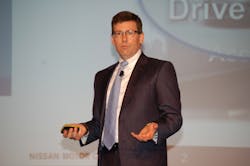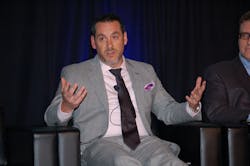Will autonomous vehicles largely spell the end of collisions — or just the end of the hardest hits that often don’t get repaired anyway?
It’s a question that although never directly addressed was certainly raised by the presentations at a recent 2-day telematics conference in Detroit centered on connected and autonomous vehicles and related technologies.
When highway safety regulators discuss accident avoidance technology and autonomous vehicles, they generally focus not on reducing accidents per se but rather on reducing the number of people killed in vehicle crashes.
“It’s a 747 crashing every week for a year,” conference speaker Mark Rosekind, administrator of the National Highway Traffic Safety Administration, said of the 38,000 Americans killed on U.S. roads last year. “That is unacceptable.”
Rosekind’s comments to 3,000 representative of automakers, technology companies, government agencies and insurers at the conference may be the latest signal that regulators aren’t expecting an accident-free future, just a reduction in the number of severe, deadly wrecks.
Rosekind, whose agency is finalizing federal regulations for self-driving vehicles, said he is frequently asked how much safer autonomous cars must be. He said a twofold increase in vehicle safety seems like an appropriate starting point.
“So while I’m not setting it at the moment, we need to start with two times better, and let’s work from there, to see what we can get,” Rosekind told the gathering of automakers, technology firms, government agencies and insurers.
He included many predictions as to likely “disruptors” in the automotive industry, including when “Level 3” conditionally autonomous vehicles (which still allow control by a driver) and “Level 4” fully-autonomous vehicles will be for sale.
Nearly all of the six inductees to a connected car “hall of fame” at the event, for example, predicted that either Apple or Google will be the next technology firm to enter the automotive arena, perhaps even by buying an existing OEM.
“If you look at Apple’s development environment, they have created mechanisms so they can allow their partners to very quickly develop new technologies, not to mention the fact that they have billions of dollars sitting in the bank ready to go,” Charles Link of M2MD Technologies said. “In defense of Detroit, building a car is a lot more complex than building a laptop or a tablet. But the first company I expected to fall on their face was Tesla, and the test of time has shown they built a pretty good product.”
Fred Blumer of vehicle telematics company Vehcon, agreed that anyone who believes Detroit will remain the hub of vehicle development needs to spend some time driving in Silicon Valley.
“My favorite experience was watching a dog on the side of the road that was behaving bizarrely,” Blumer said. “I was two cars behind a driverless vehicle and thought, ‘This is not predictable behavior; let’s see what this car does.’ It responded perfectly to the erratic behavior of that dog that ran into and out of traffic.”
But John Schnoes, director of Nissan’s autonomous driving program, leaned heavily on sarcasm when he began his prediction about the first arrival of autonomous vehicles with, “Boy, there are no difficulties in delivering Level 4.”
Schnoes said Level 3 vehicles will likely arrive in 2020, but offered no prediction for fully-autonomous vehicles. Many speakers at the conference concurred with the 2020 timeline for conditionally autonomous vehicles.
“But it’s probably going to be 10 years, 2025 or 2026, before you have the ability to have that driverless autonomous vehicle,” Link predicted, a timeline echoed by others at the conference.
“October 7, 2026,” Blumer joked.
“From our perspective, the industry doesn’t want to put something out that will negatively affect future sales and reputation,” one Michigan state regulator said, noting there are legal and governmental hurdles, not just technology challenges, that must first be overcome.
Industry consultant Francis Dance agreed that the autonomous vehicle industry is currently in the “peak of hype.”
“But it’s going to happen, and happen much quicker than anything else that has happened to the automotive industry,” Dance predicted. “We are really on a paradigm shift.”
Event coordinator Gareth Ragg of TU-Automotive cited one anonymous prediction submitted just prior to the event: “The first major accident involving an autonomous vehicle will happen in the next 12 months, a defining moment for this technology.” Ragg said there is, of course, no way to know when such an accident will actually occur.
“But to think this won’t happen is to bury our heads in the sand,” Ragg said. “And this prediction is totally right in that how we respond is going to define this industry.”
On that topic, several panel discussions at the event focused on the growing role vehicle telematics could
play in insurance claims. John Kramer, a former Nationwide Insurance executive now with Octo Telematics, which maintains what it calls the world’s largest insurance telematics statistical database, said insurers in other countries are ahead of U.S. insurers in using data from the vehicle as part of the claims process.
“Our experience in Europe has shown that our partners have…been able to reduce cycle time and actually drive down the costs of claims, seeing a noticeable difference in their loss ratios, attributable to the use of telematics,” Kramer said.
He said one way insurers are using vehicle data is from the very point of impact, determining a collision has occurred based on changes in the vehicle’s behavior.
“When there is a crash, there is a ‘first notice of loss’ that is provided to the insurance company within minutes of the observance of the [vehicle] behavior,” Kramer said. “The information is provided to the insurance company so they can make business rules in terms of how to take action.”
Other speakers at such conferences have suggested that insurers (or automakers) could even contact the driver at the scene of the accident based on such telematics data. Although Kramer didn’t provide any details about what U.S. insurers his company is working with nor how those insurers are using the telematics data, he did say, “We have two partners who are in the pilot stage of this.”
Jim Levendusky, vice president of Verisk Insurance Solutions, which is launching an “exchange” later this year to help gather connected car data to deliver to insurers, agreed the technology will mean a shift for insurers.
“The use of telematics in a claims response is something new for most insurers,” he said. “It’s not something they are accustomed to doing, and there’s a learning curve associated with that. So it’s going to take time for them to adopt. Today the claims process is very reactive. The person has some sort of claim or loss and it’s up to them to report it to their insurers agent or carrier. But in the telematics world…I think you will see a big shift to [insurers] being proactive.”




